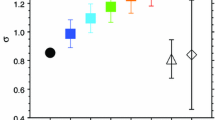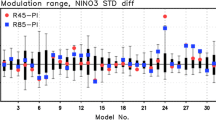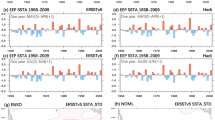Abstract
Observations indicated that for the El Niño/Southern Oscillation (ENSO) there have been eastward displacements of the zonal wind stress (WS) anomalies and surface heat flux (short wave heat flux and latent heat flux) anomalies during El Niño episodes in the 1981–1995 regime relative to the earlier regime of 1961–1975 (without corresponding displacements during La Niña episodes). Our numerical experiments with the Zebiak–Cane coupled model generally reproduced such displacements when the model climatological fields were replaced by the observed climatologies [of sea surface temperature (SST), surface WS and surface wind atmospheric divergence] and simulated climatologies (of oceanic surface layer currents and associated upwelling) for the 1981–1995 regime. Sensitivity tests indicated that the background atmospheric state played a much more important role than the background ocean state in producing the displacements, which enhanced the asymmetry between El Niño and La Niña in the later regime. The later regime climatology state resulted in the eastward shifts in the ENSO system (WS and SST) only during El Niño, through the eastward shift of the atmosphere convergence heating rate in the coupled model. The ENSO period and ENSO predictability were also enhanced in the coupled model under the later regime climatology. That the change in the mean state of the tropical Pacific atmosphere and ocean after the mid 1970s could have produced the observed changes in ENSO properties is consistent with our findings.









Similar content being viewed by others
References
An S-I (2004) Interdecadal changes in the El Niño La-Niña asymmetry. Geophys Res Lett 31:L23210. DOI 10.1029/2004GL021699
An S-I, Wang B (2000) Interdecadal change of the structure of the ENSO mode and its impact on the ENSO frequency. J Clim 13:2044–2055
Barnett TP, Pierce DW, Latif M, Dommenget D, Saravanan R (1999) Interdecadal interactions between the tropics and midlatitudes in the Pacific basin. Geophys Res Lett 26(5):615–618. DOI 10.1029/1999GL900042
Boulanger J-P, Menkes C (2001) The Trident Pacific model. Part 2: role of long equatorial wave reflection on sea surface temperature anomalies during the 1993–1998 TOPEX/POSEIDON period. Clim Dyn 17:175–186
Bourassa MA, Smith SR, O’Brien JJ (2001) A new FSU winds and flux climatology. In: 11th conference on interactions of the sea and atmosphere. Am Meteor Soc, San Diego, pp 9–12
Chen D, Cane MA, Kaplan A, Zebiak SE, Huang D (2004) Predictability of El Niño in the past 148 years. Nature 428:733–736
daSilva A, Young AC, Levitus S (1994) Atlas of surface marine data 1994. Tech Rep 6, US Department of Commerce, NOAA, NESDIS
Fedorov AV, Philander SGH (2001) A stability analysis of tropical ocean–atmosphere interactions (bridging measurements of, and theory for El Niño). J Clim 14:3086–3101
Flügel M, Chang P, Penland C (2004) The role of stochastic forcing in modulating ENSO predictability. J Clim 17:3125–3140
Gu D, Philander SGH (1997) Interdecadal climate fluctuations that depend on exchanges between the Tropics and extratropics. Science 275:805–807
Hsieh WW (2004) Nonlinear multivariate and time series analysis by neural network methods. Rev Geophys 42(1):RG1003. DOI 10.1029/2002RG000112
Jin F-F, An S-I, Timmermann A, Zhao J (2003) Strong El Niño events and nonlinear dynamical heating. Geophys Res Lett 30:1120. DOI 10.1029/2002GL016356
Kleeman R, McCreary JP, Klinger BA (1999) A mechanism for generating ENSO decadal variability. Geophys Res Lett 26:1743–1746
Knutson TR, Manabe S (1998) Model assessment of decadal variability and trends in the tropical Pacific Ocean. J Clim 11:2273–2296
Kramer MA (1991) Nonlinear principal component analysis using autoassociative neural networks. AIChE J 37:233–243
Latif M, Barnett TP (1996) Decadal climate variability over the North Pacific and North America: dynamics and predictability. J Clim 9:2407–2423
Li S, Hsieh WW, Wu A (2005) Hybrid coupled modeling of the tropical Pacific using neural networks. J Geophys Res (Oceans) (accepted)
McPhaden MJ, Zhang D (2004) Pacific Ocean circulation rebounds. Geophys Res Lett 31:L18301. DOI 10.1029/2004GL020727
Rodgers KB, Friederichs P, Latif M (2004) Tropical Pacific decadal variability and its relation to decadal modulations of ENSO. J Clim 17:3761–3774
Smith TM, Reynolds RW (2004) Improved extended reconstruction of SST (1854–1997). J Clim 17:2466–2477
Tang B (1995) Periods of linear development of the ENSO cycle and POP forecast experiments. J Clim 8:682–691
Tang Y, Hsieh WW (2002) Hybrid coupled models of the tropical Pacific – ENSO prediction. Clim Dyn 19:343–353
Thompson CJ, Battisti DS (2001) A linear stochastic dynamical model of ENSO. Part II: Analysis. J Clim 14:445–466
Tziperman E, Zebiak SE, Cane MA (1997) Mechanisms of Seasonal–ENSO interaction. J Atmos Sci 54(1):61–71
Wang B, An S-I (2001) Why the properties of El Niño changed during the late 1970s. Geophys Res Lett 28:3709–3712
Wang B, An S-I (2002) A mechanism for decadal changes of ENSO behavior: Roles of background wind changes. Clim Dyn 18:475–486. DOI 10.1007/s00382-001-0189-5
Wu A, Hsieh WW (2003) Nonlinear interdecadal changes of the El Niño-Southern Oscillation. Clim Dyn 21:719–730. DOI 10.1007/s00382-003-0361-1
Zebiak SE, Cane MA (1987) A model El Niño–Southern Oscillation. Mon Weather Rev 115:2262–2278
Zhang Y, Wallace JM, Battisti DS (1997) ENSO-like interdecadal variability: 1900–93. J Clim 10:1004–1020
Zhang R-H, Kleeman R, Zebiak SE, Keenlyside N, Raynaud S (2005) An empirical parameterization of subsurface entrainment temperature for improved SST anomaly simulations in an intermediate ocean model. J Clim 18:350–371
Zwiers FW, von Storch H (1995) Taking serial correlation into account in tests of the mean. J Clim 8:336–351
Acknowledgements
We are grateful to Drs. A. Wu and S. Li for helpful discussions, and Dr. R.-H. Zhang for the valuable suggestion on the computation of the subsurface temperature. The Zebiak–Cane coupled model, developed originally by Drs. S.E. Zebiak and M.A. Cane, was kindly made available by the Lamont-Doherty Earth Observatory. This work was supported by the Canadian Foundation for Climate and Atmospheric Sciences, and the Natural Sciences and Engineering Research Council of Canada.
Author information
Authors and Affiliations
Corresponding author
Rights and permissions
About this article
Cite this article
Ye, Z., Hsieh, W.W. The influence of climate regime shift on ENSO. Clim Dyn 26, 823–833 (2006). https://doi.org/10.1007/s00382-005-0105-5
Received:
Accepted:
Published:
Issue Date:
DOI: https://doi.org/10.1007/s00382-005-0105-5




